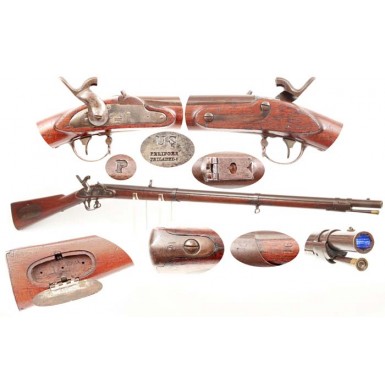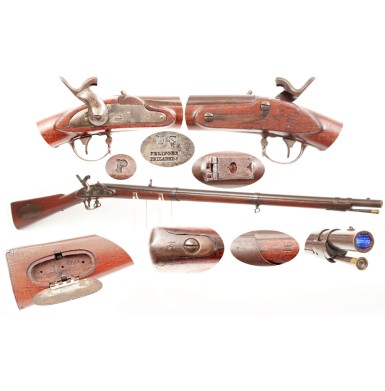Deringer Contract Percussion Military Rifle - Excellent & Scarce
- Product Code: FLA-2880-SOLD
- Availability: Out Of Stock
-
$1.00
The name of gunmaker Henry Deringer Jr. is probably one of the best known in the world of historic and collectible American firearms. Few gunmakers have risen to the iconic status of Colt, Smith & Wesson and Remington, but Deringer’s name has even become a part of our daily language, with the sobriquet “derringer” being applied to many pocket size firearms, regardless of their actual manufacture, much like the brand names Xerox and Kleenex have become equally useful generic descriptions for the products they pioneered, no matter who actually made the item. While Deringer’s fame may reside primarily in his infamous pocket pistols, he produced a wide range of firearms during his lifetime, with many of them being military contract arms for the US government. Henry Deringer Jr. was the son of Henry Deringer, a Richmond, VA gunmaker (pre-1769) who moved to Pennsylvania in 1769 and according to Seller’s worked in Philadelphia from 1769-1814 and in Easton, PA from 1786-1798. Henry Jr. worked in Richmond from 1807-1808 and moved to Philadelphia in 1808. He succeeded to his father’s business in 1814 and continued to receive the lucrative government military contracts that had originally been let to his father. Henry Jr.’s contracts included the US M-1814 Rifle, the US M-1817 Rifle, and the US M-1842 Naval Pistol, just to name the largest and best known. He also produced a large number (more than 8,000) Indian trade guns for the US government during the 1830s and 1840s. With the coming of the American Civil War, Deringer sought to obtain military contracts to deliver rifles and rifle muskets to the state of Pennsylvania, and hopefully to the Federal government as well. To that end began the production of a .69 caliber percussion rifle musket based upon the US M-1816/22/28 series of arms, and a percussion rifle (in both .54 and .58 calibers), based upon his US M-1817 contract rifles. Deringer approached the US Ordnance Department about the possibilities of his rifle being accepted for US service, and according arms historian, researcher, and author George Moller, it appears that Deringer may have received a somewhat positive reply. However, no known US government contract for his percussion rifles is known. Moller’s research suggests that at least some of the rifles may have been purchased by the state of New Jersey, as that state’s 1861 Quartermaster General Report notes “more than 1,000 percussion rifles of various types in the Trenton State Arsenal, and in the hands of the militia at the beginning of that year.” Moller notes that this same report listed “280 Deringer percussion rifles” were currently issued to various state militia companies. Moller notes that the rifles appear to be a mixture of US M-1817 flintlock rifle parts and newly manufactured parts of the same pattern. Some of the locks are newly made as percussion locks from unfinished (and undrilled) US M-1817 rifle locks, and others utilized altered locks. The same applied to the barrels. While all are 36” long and round, some of the rifles used newly made percussion barrels and others used percussion altered US M-1817 flintlock rifle barrels. This may explain why some of the extant examples have .54 caliber bores (altered flintlock barrels) and some are .58 caliber (newly made barrels). In both cases, the gun feature the stocks and furniture of the Deringer contract M-1817 rifles, and have some rather unique, identifying features. These include an elongated percussion bolster very similar in profile to those used on Deringer’s US M-1842 “Box Lock” Naval Pistols. This bolster is integral to the newly made barrels, and is brazed on the barrels altered from flintlock. The rifles also used a unique rear sight that reminds me of a very flimsy copy of the Eli Whitney Jr. “Mid Range” rear sight. The sight has a 1” base that is dovetailed into the barrel and has an L shaped leaf that is set for 100 yards in the down position, and has a pierced aperture that is set for 300 yards when in the up position. The notched top of the leaf is likely set for 500 yard shooting. Interestingly the rear sight has no graduations or markings on it, and the leaf itself is very thin and flimsy. Examples are known to exist with both browned and bright finishes, but it seems reasonable that the rifles were originally manufactured with browned barrels and furniture, and with color case hardened locks, just as the M-1817 rifles were. Moller’s research suggests that at least 200 of these rifles were produced between 1861 and 1862, and possibly as many as 1,000. However, the scarcity of surviving examples suggests the number is likely closer to 200 than to 1,000, making these relatively rare rifles on today’s collectors market.
This example of the Deringer Rifle (Flayderman (9A-234) is in truly EXCELLENT condition and is probably the best example I have ever seen. The gun is really stunning and retains the large majority of its original finish and is extremely crisp throughout. The gun is 100% correct and original and is extremely attractive. The lock of the rifle is crisply and clearly marked: US / DERINGER / PHILADEL. It is suggested that the presence of the “US’ mark suggests the use of an old (although undrilled) US M-1817 lock plate. The 2-line marking stamp with the Deringer name is the exact same stamp found on the locks of his US M-1842 Naval Box Lock pistols with the rifled bores, but the separate “US’ stamp appears to be a different die than the one used on those pistols. As the two markings were likely applied at two different times, I think the “US’ might have been struck on the newly made percussion lock in anticipation of US government sales, and not because the lock plate was old stock. The lock follows the general shape and contours of the M-1817 rifle lock, but was never drilled for any of the external flintlock battery screws, nor was the top edge machined for the brass pan. The lock is smooth, with only some very lightly scattered pinpricking and minor surface oxidation. The lock plate retains about 30% of its original case hardened finish, with the most vivid area being around the middle of the lock where the plate is protected by the hammer neck when the hammer is in the down position. The balance of the lock shows a mixture of faded smoky grays and browns with some darker mottling suggesting the original case coloring. The US M-1842 style hammer shows traces of case colored mottling and has a medium pewter gray base color, combined with mottled browns and darker grays (as well as some traces of blues), again suggesting the original case hardening. The lock is mechanically EXCELLENT and works perfectly on all positions and remains very crisp. The barrel retains about 90%+ of its original lacquer browned finish, with only some fading and minor loss from handling noted. There are some tiny areas where finish was lost to scarping or handling, and these are primarily along the high edges and contact points. The barrel is mostly smooth, but does show some scattered patches of lightly oxidized surface roughness, scattered pinpricking and minor peppering. The barrel is one of the newly made percussion barrels with an integral, elongated bolster. The only mark on the top of the barrel is a single P proof mark. However the bottom of the barrel shows two sets of mating marks. The Roman numerals XXVIII and XVII are both present on the bottom of the barrel. The matching mark XVII is found in the stock mortise cut for the breech plug tang, and the mark XXVIII is found in the patchbox cut out of the stock. The bore of the rifle is in about EXCELLENT condition and retains very crisp, deeply cut rifling that extends through the muzzle with no crown, as on Deringer’s “Common Rifles”. The rifling was clearly cut with the same machines as he used for his earlier rifle contracts, as the 7 grooves are cut at a relatively fast 1:48”, which is about the right rate of spin for a round ball rifle. It is rather fast for an elongated or Mini” style bullet, which is normally spun at a much slower 1:72” rate. The bore of the rifle is .58 caliber, so it was clearly intended for use with Mini” style ammunition, even though the rifling pitch rate was not optimum for that type of bullet. The furniture of the rifle retains anywhere from about 50%+ original faded brown (side plate) to about 90%+ (the barrel bands). The matchbox cover, buttplate and trigger guard all retain strong amounts of browning, with about 60% on the buttplate, 70% on the patchbox cover and more like 85%+ on the triggerguard. All of the furniture shows some thinning to the finish, some minor loss due to handling and some lightly oxidized pinpricking scattered about the metal. Even the screwheads show only minimal slot wear, and all appear to retain at least 50%+ of their browned finish. The top of the buttplate tang is crisply stamped 16 behind the tang screw, and the same 16 can be found stamped on the left side of the upper barrel band and on the left side of the stock, immediately behind the upper barrel band. The original and correct folding leaf rear sight is in place in the dovetail on the top of the barrel and the correct and original front sight is in place on the top of the barrel, near the muzzle. Both of the original sling swivels are in place on the rifle, and the original brass-tipped, trumpet head ramrod is in place in the channel under the barrel. The rod is full length and retains fine threads o the end to attach cleaning implements. The stock of the rifle rates about NEAR EXCELLENT and remains very crisp and sharp throughout. The stock is solid and complete and free of any breaks or significant repairs. There is a tiny chip of wood that was knocked out of the stock immediately behind the barrel tang, which was set back into the stock and is practically unnoticeable to the naked eye. I only saw it when viewing a blown up high-resolution photo of the area. This is extremely minor and is mentioned for exactness, and would likely pass unnoticed to nearly any buyer. The stock does show a number of bumps, dings, handling marks, minor mars and scattered minor scrapes. These are no doubt the result of year of storage, light handling, and possibly some light field use by the New Jersey militia. The stock retains fine lines and edges and shows not signs of having been sanded or abused in any way.
Overall, this is a really wonderful example of a very scarce American Civil War militia rifle by one of the most famous American gunmakers of all time. These Deringer Percussion Rifles were made in very limited quantities, but it appears that at least some were purchased by the state of New Jersey in 1861 and at least 280 “Deringer Percussion Rifles’ were issued to the state militia during that year. These rifles are rarely found on the market for sale and when they are they are simply not in this fantastic state of preservation. This is one of those great, scarce Civil War rifles that just doesn’t come up for sale very often, and practically never in this condition. This is one of those guns you’ll wish you had jumped on when you see that it has sold to another collector, so don’t miss your chance.
SOLDTags: Deringer, Contract, Percussion, Military, Rifle, Excellent, Scarce








